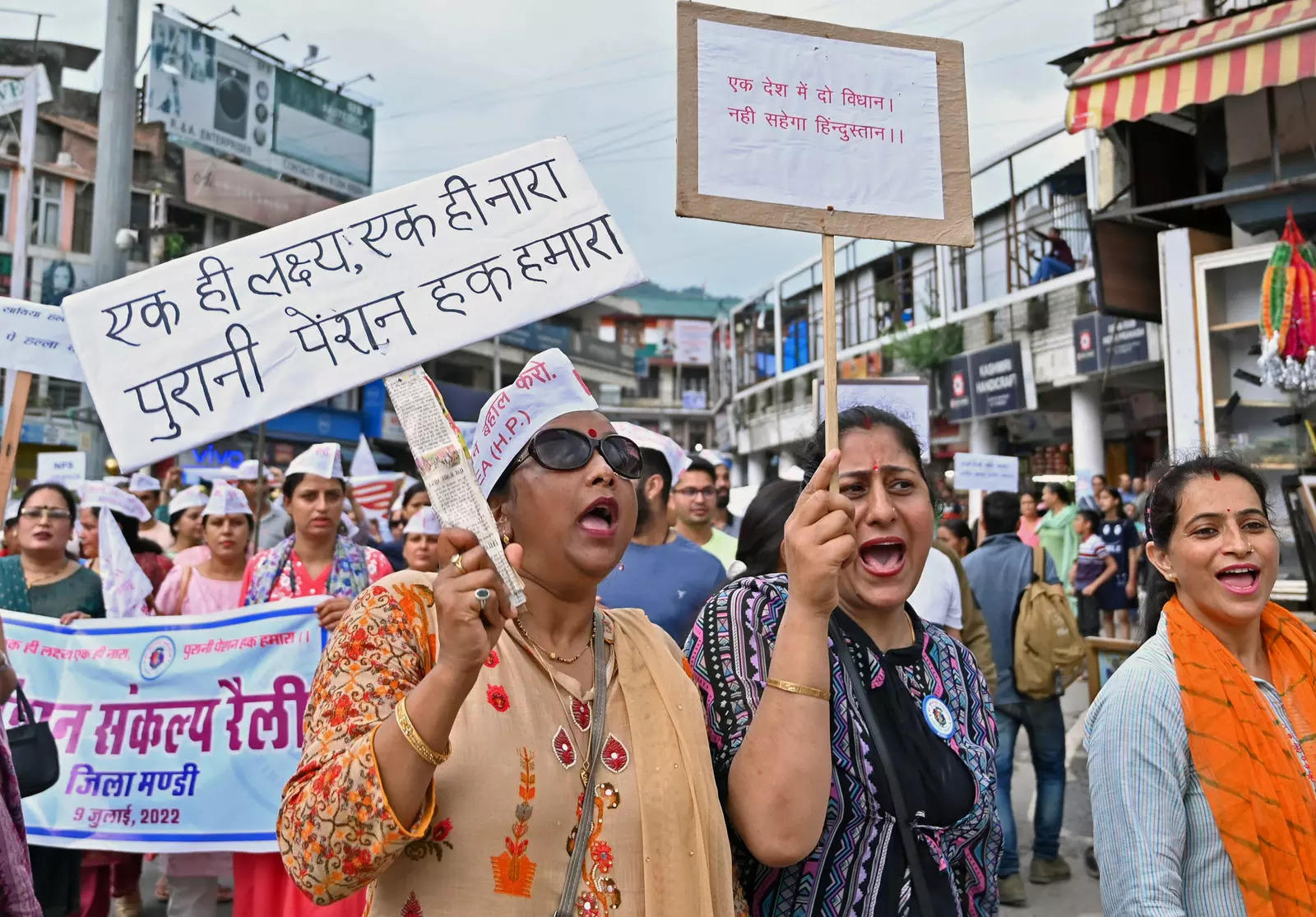
Congress and AAP have made restoration of Old Pension Scheme a major poll plank during poll campaigns in Himachal Pradesh and Gujarat. However, turning the clock back on reforms may fetch electoral gains to parties, but is certainly not good economics, writes Rajendra Khatry
The demand for restoration of the old pension scheme has been there for several years in the country. But of late it has gained momentum, especially in the light of the assembly elections in some states.
In fact, demand for the old pension scheme has become a major election issue in some states which want the new scheme to be rolled back and the old pension scheme restored. Opposition in BJP-ruled states like Himachal Pradesh and Gujarat, especially, are promising to restore the old pension scheme knowing fully well that such a promise will lure voters, while it will be difficult for the BJP to make any such announcement.
Earlier, Congress-ruled Rajasthan said it will bring back the old pension scheme in the state from the next financial year, and Chhattisgarh is expected to follow suit. Both the Congress and the Aam Aadmi Party (AAP) have promised the electorates in Himachal Pradesh and Gujarat that if they come to power there they will restore the old pension scheme.
Meanwhile, the ruling AAP in Punjab has already announced the restoration of the old pension scheme after a cabinet nod. AAP hopes the action in Punjab and the promise of the old pension scheme implementation in Himachal Pradesh and Gujarat if the party comes to power will help it garner a huge chunk of votes in their favour.
Similarly, the Congress hopes that the announcement in Rajasthan and promise in Himachal Pradesh will improve its election prospects in the upcoming polls.
However, the issue has put the BJP in a dilemma. The BJP which is in favour of status quo, has not made any such announcement with regard to the pension scheme. The BJP knows that any announcement in some states in favour of implementing the old pension scheme will be critical for it. With such an announcement by the BJP, there will be similar demands from other BJP ruled states in the country, which the party will find it very difficult to fulfil for the sheer economic burden it will incur on the national exchequer.
Under the old pension scheme, employees got a pension under a predetermined formula which was half of the last drawn salary. They also got the benefit of the revision of Dearness Relief (DR), twice a year. The payout was fixed and there was no deduction from the salary.
The government introduced the National Pension System (NPS) with effect from January 2004 (except for armed forces). In 2018-19, to streamline the NPS and make it more attractive, the Union Cabinet approved changes in the scheme to benefit central government employees covered under NPS. The NPS was launched as a way for the government to get rid of pension liabilities.
According to a report, from the early 2000s, India’s pension debt was reaching uncontrollable levels. On introduction of NPS, the Central Civil Services (Pension) Rules, 1972 was amended. The NPS allows subscribers (government employees) to decide where they want to invest their money by contributing regularly in a pension account throughout their career.
Under the scheme, after retirement, the beneficiaries could withdraw a part of the pension amount in a lump sum and use the rest to buy an annuity for a regular income.
Incidentally, the implementation of NPS is being implemented and regulated by PFRDA (Pension Fund Regulatory and Development Authority) in the country. National Pension System Trust (NPST) established by PFRDA is the registered owner of all assets under NPS.
The All Citizens Model of the NPS allows all citizens of India (including NRIs) aged between 18 – 70 years to join NPS. It is a participatory scheme, where employees contribute to their pension corpus from their salaries, with matching contributions from the government. The funds are then invested in earmarked investment schemes through Pension Fund Managers. In the year 2019, the Union Finance Ministry said that Central government employees have the option of selecting the Pension Funds (PFs) and Investment Pattern. At retirement, they can withdraw 60 per cent of the corpus, which is tax-free and the remaining 40 per cent is invested in annuities, which is taxed.
The old pension scheme was discontinued in 2004 by the NDA government in the country. According to experts, longer life spans mean more pension payout which puts burden on the exchequer. For instance, employees retiring at 60 and having an average lifespan of nearly 85 years or more have to be paid for over two decades after superannuation. Even after the death of the pensioner, their spouses are entitled for a portion of the pension under the OPS.
The old pension scheme (OPS) led to a massive pension burden on the Union and state governments. Under the old scheme, employees got a pension under a predetermined formula which is half of the last drawn salary. They also get the benefit of the revision of Dearness Relief (DR), twice a year. The payout is fixed and there was no deduction from the salary.
Under the OPS, there was the provision of the General Provident Fund (GPF). But the new pension scheme (NPS) requires employees to deposit 10 per cent of the basic pay, along with the dearness allowance. There is no GPF advantage and the amount of pension is not fixed. The major issue with the scheme is that it is market-linked and return-based.
This means that the payout is uncertain. The Pension Fund Regulatory and Development Authority was established by an enactment of the Parliament, to regulate, promote and ensure orderly growth of the National Pension System (NPS). It works under the Department of Financial Services under the Ministry of Finance. It performs the function of appointing various intermediate agencies like Pension Fund Managers, Central Record Keeping Agency (CRA) etc. It develops, promotes and regulates the pension industry under the NPS and also administers the APY (Atal Pension Yojana).
It is true that there will be short-term gains for the states if the old pension scheme is restored but as pension liabilities will increase over time, the space for more productive forms of expenditure will be curtailed. This will be harmful to those states in the long run.
What is not being talked about by any party today is that the burden of funding these pensions will fall on future generations. Instead of focusing on the immediate return and relief, political parties need to take a long term view. They should resist the temptation for such fiscally imprudent moves.













